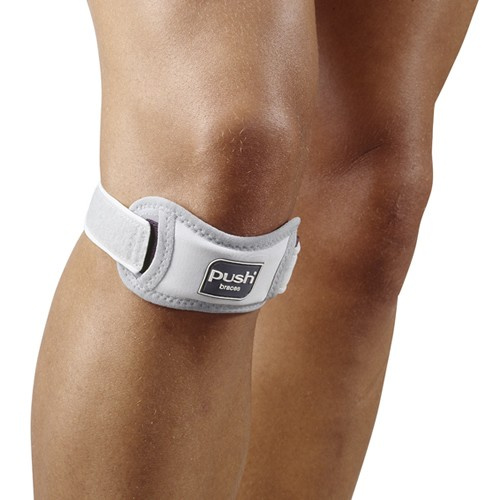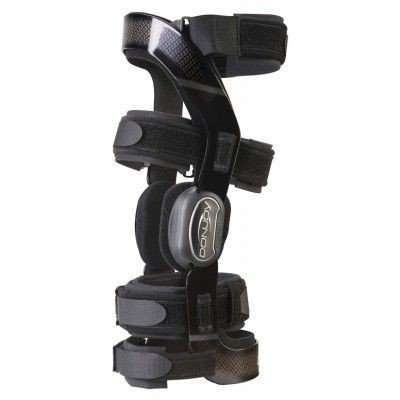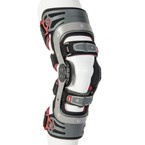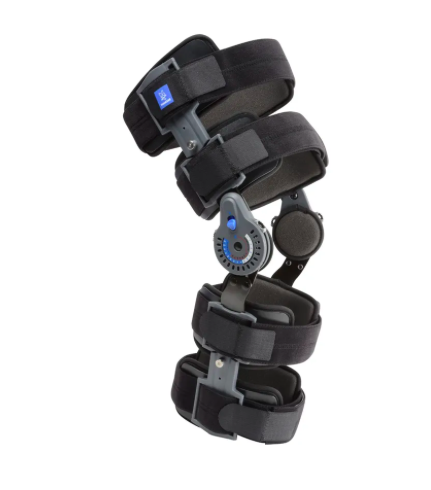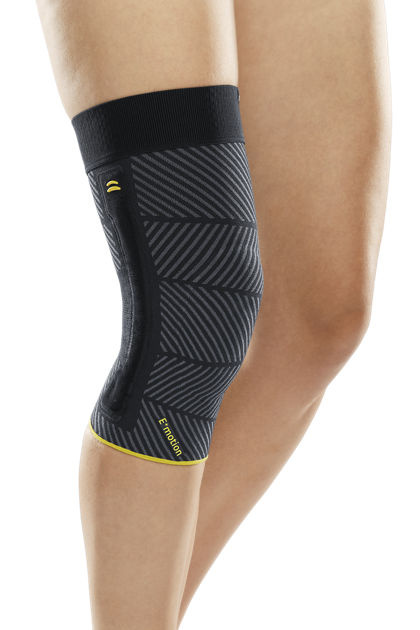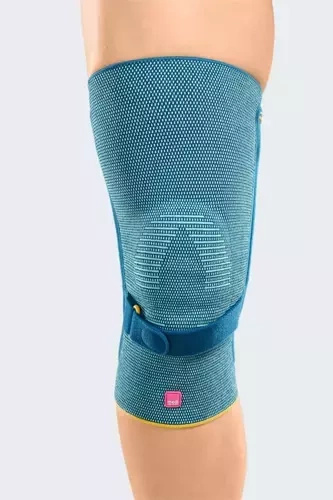Basketball knee injuries and treatment options
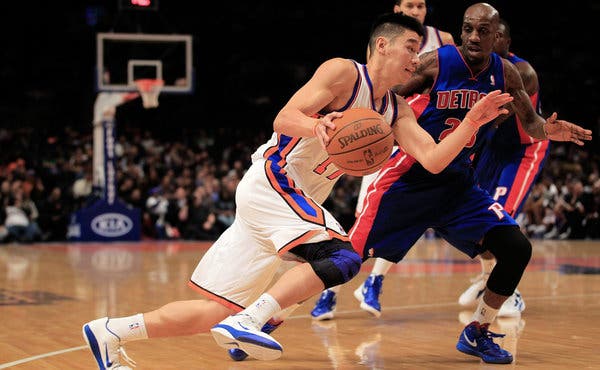
Basketball players put their bodies through intense training before each game - especially their knees. As a result, even the best basketball players sustain knee injuries, some of which can end their careers. However, there are also treatment options, like knee braces, which can help get athletes back in the game in no time.
What are the types of basketball knee injuries?
Like most physically challenging sports, basketball takes a significant toll on players - especially on their legs and knees. This sport demands that basketball players extensively utilize their legs, joints and muscles to run, jump, stretch and stop suddenly - all of which can lead to painful knee injuries (Manhattan Orthopedic Care). The most common types of knee injuries that affect basketball players are knee sprains, strains, and various tears. Let’s face it, playing basketball can come with risks if you’re not too careful.
What are the types of basketball knee injuries?
Knee sprains occur when the ligaments of the knee become overstretched, which tends to occur when a basketball player stops abruptly or makes a rapid change in motion (Manhattan Orthopedic Care). The warning signs that you may have a knee sprain are pain, swelling and bruising of the knee, as well as instability when walking (Mercy Health). Ligaments that hold the knee bones together become weaker and more prone to tears, such as an ACL tear. If an ACL tear occurs, getting ACL surgery might be the only treatment option (Kevin Freedman, M.D).
Treating a knee ligament sprain requires immobilization of the affected knee, rest, pain relief products and a knee brace - however, knee injuries should be diagnosed by a medical specialist, who will also recommend the best knee brace for your condition.
Knee strains
Another common injury basketball players often suffer from are knee strains - the most common variant being patellar tendonitis, or better known as Jumper’s knee (Manhattan Orthopedic Care). This condition occurs during excessive jumping over long periods of time, which overstretches the tendons of the knee. Symptoms include pain and tenderness of the patellar tendon, swelling, tenderness around the kneecap and pain when moving, bending or straightening the leg (Manhattan Orthopedic Care). Strains should be treated with rest, ice packs (to reduce swelling), simple stretching and strengthening exercises and anti-inflammatory drugs. Before undergoing treatment, it is best that you speak with a doctor or physical therapist, in order to get a proper assessment of your condition.
Knee tears
Unlike strains and sprains, tears require more than just an ice pack for treatment. Even the best basketball players are prone to experiencing tears in the knee - the most common examples types are:
ACL tears - a tear of the anterior cruciate ligament. This ligament is found under the kneecap and keeps the knee stable. Tears can result from quickly changing direction when running or stopping abruptly during intense physical activity (ACL Injury).
PCL tears - A tear of the posterior cruciate ligament. This ligament is found behind the ACL and tears to this ligament are less common than those of the ACL. This ligament connects the femur to the tibia and is stronger than the ACL, however, it can still be torn (Posterior Cruciate Ligament Injury). The PCL can be torn if a blow to the front of the knee is delivered, or due to hyperextension (Posterior Cruciate Ligament Injury).
Meniscus tears - a tear of the lateral or medial meniscus cartilage. This cartilage is found on top of the tibia and works as a cushion that stabilizers the knee joint and protects the bones from wearing down. These tears are common among athletes who play basketball or any other contact sport. All it takes is a sudden change in direction when running, or twisting the knee and you’re more likely to tear this cartilage (Meniscus Tear Knee Injury).
Tear symptoms and treatment options
All three of these tears share similar symptoms, which include pain in the knee, swelling in the affected area and difficulty walking. No matter which of these injuries you’ve sustained, it is vital that you avoid exerting pressure on the affected leg and apply an ice pack if you experience swelling (Manhattan Orthopedic Care). You may also want to keep your knee elevated in order to stimulate blood flow away from the knee, as any internal bleeding sustained during the injury can cause pressure on the joint. Since the knee joint is so compact, it is best to speak with a doctor in order to identify your injury. When it comes to identifying whether or not you have an ACL or PCL tear, your doctor will run a physical test and have you bend your leg in certain angles in order to spot any abnormal knee movement (ACL Injury)(Posterior Cruciate Ligament Injury). As for diagnosing a meniscus tear, x-rays or even an MRI scan may be required (Meniscus Tear Knee Injury).
When it comes to treating these knee injuries, assessing their severity is top priority. In the case of a minor tear, you should avoid standing on the affected leg for some time, take pain relief and anti-inflammatory medication prescribed by your doctor, keep your leg raised to reduce swelling and utilize a knee brace for added support. If your knee injury is severe, your doctor may recommend surgery followed by physical therapy and a knee brace to immobilize your leg. You can expect a full recovery after meniscus tear surgery in 4 to 6 weeks (Meniscus Tear Knee Injury) - as for ACL and PCL tear surgery, proper recovery might even take up to 12 months (ACL Injury)(Posterior Cruciate Ligament Injury).
How to find the best basketball knee brace?
Whether you’ve sustained sprains, strains, ligament and cartilage tears, or are recovering from surgery after severe knee injuries, a knee brace should be with you every step of the way on your road to recovery. When looking for the best knee brace for basketball players, you need to take into account your condition. Since knee braces and compression knee sleeves are certified medical equipment, you should consult with your doctor and ask which option would be best for your condition. If you have minor sprains and strains and have difficulty keeping your knee stable, a soft knee sleeve or hinged brace would be your best bet - as for more severe injuries, the best knee brace option would have to include a locking feature, in order to immobilize the knee and ensure a complete recovery. You can find more information on the various types of knee braces and where to purchase yours medical accessories here.
How to prevent future knee injuries?
When playing basketball, there’s always a chance that you may sustain an injury - but you can significantly reduce this risk by taking a number of precautions, including:
- Doing light stretches after a game and resting prior to your next one.
- Focusing on your leg muscles during workouts - especially thigh muscles (Manhattan Orthopedic Care).
- Making sure you have comfortable footwear with anti slip features.
- Wearing a knee brace prophylactically.
A well-chosen brace for basketball can be worn as knee protection in order to prevent various injuries, which is especially helpful for athletes who have recurring injuries or have unstable knees. However, even if you’re considering purchasing a brace for prophylactic reasons, you should still consult with your doctor or physical therapist and ask which model is best for you.
Sources:
- How to avoid basketball knee injuries and enjoy a good game?” Manhattan Orthopedic Care, APRIL 4, 2016 https://www.mocnyc.com/how-to-avoid-basketball-knee-injuries-and-enjoy-a-good-game/#:~:text=The%20most%20common%20type%20of,of%20pressure%20on%20the%20tendons
- Knee Strain or Sprain” Mercy Health, 2020 https://www.mercy.com/health-care-services/orthopedics-sports-medicine-spine/specialties/knee-leg/conditions/knee-strain-sprain
- Basketball Knee Injury 101: Six Common Injuries to Avoid” Kevin Freedman, M.D., November 20th, 2018 https://rothmanortho.com/stories/blog/Basketball-Knee-Injury
- ACL Injury: What to Know”, WebMD, 2018 https://www.webmd.com/pain-management/knee-pain/acl-injury-what-to-know#1
- Posterior Cruciate Ligament Injury”, WebMD, 2020 https://www.webmd.com/fitness-exercise/posterior-cruciate-ligament-injury#1
- Meniscus Tear Knee Injury” , WebMD, 2020 https://www.webmd.com/pain-management/knee-pain/meniscus-tear-injury#1

